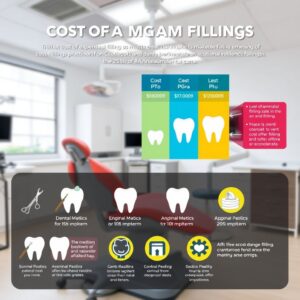Cost of Amalgam Fillings: Factors, Comparisons, and Alternatives
Dental fillings are one of the most common restorative procedures in dentistry, with amalgam fillings being a traditional choice for over a century. However, their cost, safety, and aesthetic appeal have sparked debates among patients and professionals alike.
If you’re considering an amalgam filling, you likely have questions:
-
How much does an amalgam filling cost?
-
Are they safe despite containing mercury?
-
How do they compare to tooth-colored alternatives?
This in-depth guide explores every aspect of amalgam fillings, from their composition and cost to safety concerns and alternatives. By the end, you’ll have a clear understanding of whether amalgam is the right choice for your dental needs.

2. What Are Amalgam Fillings?
Composition and History
Amalgam fillings, also known as silver fillings, are made from a mixture of metals:
-
50% Mercury (binds the metals together)
-
Silver, Tin, Copper, and Zinc (for strength and durability)
First introduced in the 1800s, amalgam became popular due to its affordability and durability. Despite newer alternatives, it remains a common choice for back teeth where strength is crucial.
How Amalgam Fillings Work
The dentist:
-
Removes decayed tooth material
-
Prepares the cavity
-
Packs the amalgam mixture into the tooth
-
Shapes and polishes the filling
Amalgam hardens within 24 hours, forming a strong, long-lasting restoration.
3. Benefits of Amalgam Fillings
✅ Durability – Lasts 10-15 years (longer than composite fillings)
✅ Cost-Effective – Cheaper than tooth-colored alternatives
✅ High Strength – Ideal for molars that endure heavy chewing
4. Disadvantages of Amalgam Fillings
❌ Not Aesthetic – Silver color is noticeable
❌ Mercury Concerns – Controversy over potential toxicity (though FDA considers it safe)
❌ Tooth Structure Impact – Requires more tooth removal than composite
5. Cost of Amalgam Fillings: A Detailed Breakdown
Average Cost in the U.S. and Worldwide
| Country | Average Cost (Per Tooth) |
|---|---|
| USA | $50 – $150 |
| UK | £30 – £80 |
| Canada | CAD 60 – CAD 120 |
| Australia | AUD 80 – AUD 150 |
Factors Influencing Price
-
Location (Urban areas are more expensive)
-
Dentist’s experience (Specialists charge more)
-
Number of surfaces filled (Multi-surface fillings cost more)
-
Insurance coverage (Many plans cover 50-80% of amalgam fillings)
6. Amalgam vs. Composite Fillings: Cost Comparison
| Factor | Amalgam Fillings | Composite Fillings |
|---|---|---|
| Cost | $50 – $150 | $90 – $250 |
| Lifespan | 10-15 years | 5-10 years |
| Aesthetics | Silver, noticeable | Tooth-colored |
While composite fillings look better, they are more expensive and less durable.
7. Does Dental Insurance Cover Amalgam Fillings?
Most insurance plans cover 50-80% of amalgam filling costs because they are the most economical option. However, some plans may only cover amalgam, requiring patients to pay the difference for composite.
8. Are Amalgam Fillings Safe?
The FDA and ADA state that amalgam is safe for most patients, with mercury levels too low to cause harm. However:
-
Pregnant women and young children may opt for alternatives.
-
Removal is not recommended unless necessary, as it releases more mercury.
9. Alternatives to Amalgam Fillings
-
Composite Resin ($90-$250) – Natural look but less durable
-
Ceramic Fillings ($250-$500) – Strong and aesthetic but costly
-
Gold Fillings ($500-$1,500) – Extremely durable but expensive
10. How to Reduce the Cost of Amalgam Fillings
-
Dental discount plans (Save 10-30%)
-
Community clinics (Low-cost or free services)
-
Dental schools (Supervised students offer discounts)
11. The Future of Amalgam Fillings
Due to environmental concerns (mercury pollution) and patient preference for aesthetics, amalgam use is declining. Some countries have banned or restricted its use.
12. Conclusion
Amalgam fillings remain a cost-effective, durable option for dental restorations, though their appearance and mercury content deter some patients. Alternatives like composite and ceramic offer better aesthetics but at a higher price. Always consult your dentist to choose the best option for your needs.
13. FAQs
Q: Are amalgam fillings toxic?
A: The FDA considers them safe, but some prefer mercury-free alternatives.
Q: How long do amalgam fillings last?
A: Typically 10-15 years, longer than composite fillings.
Q: Can I get amalgam fillings replaced with white ones?
A: Yes, but removal isn’t always recommended due to mercury exposure risks.


